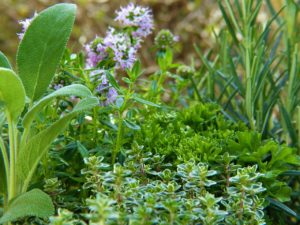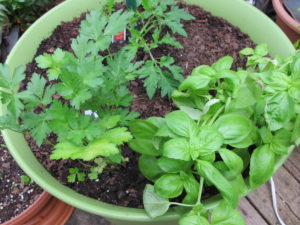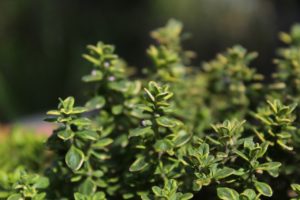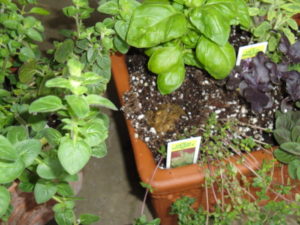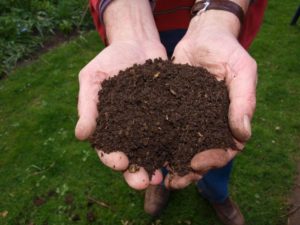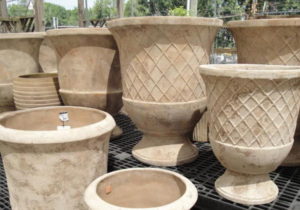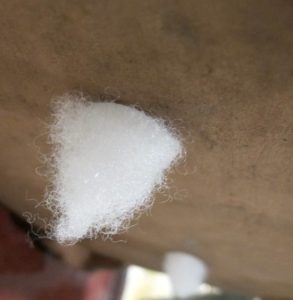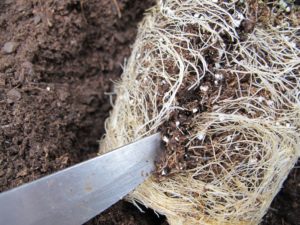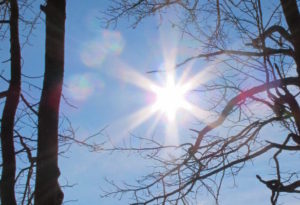Page 3
Herb Gardens Close To the Kitchen
Since moving to North Carolina in 2013, I’ve grown hardy herbs year-round. In winter, they enjoy the warmer microclimates close to the house. That’s where chives, parsley, ‘Berggarten’ sage, bay laurel, sweet marjoram, and French thyme grow nicely. In the Charlotte garden, the fenced deck protected potted herb gardens, greens, and vegetables from deer and rabbits.
It’s just a few steps outside the kitchen door when I need fresh clippings for the sauce or the soup. Since I never (well, maybe once) buy herbs in those plastic clam shells at the grocery store, none of it deteriorates in the back of the fridge. No plastic/no waste: win-win!
Heat-seeking basil grows indoors from fall through mid-spring for fresh clippings. I often pot up a few varieties for growing outside in the summer. Potted basil can be taken indoors at night when basil downy mildew threatens to damage the plants. In drier indoor air, the disease can’t get started.
Basil ‘Obsession’, one of Rutgers University’s introductions, is a new variety which promises to be resistant to basil downy mildew. In 2021, I planted this basil and flat-leaf parsley into a 20″ pot with a staked ‘Sun Gold’ cherry tomato. During a humid, rainy summer, not one speck of basil downy mildew!
Combination Pots
With a few exceptions, herbs grow perfectly well with other edibles in the same pot. Plants do not transfer flavors because the roots are entangled. It could happen, though, if a rosemary leaf rubs against a sweet basil. Just rinse the leaves before using them in the kitchen.
We shouldn’t overlook the ornamental value of herbs. Try 3 golden lemon thymes (photo, right) and 3 small pots of white sweet alyssum (flowering annual with edible flowers) in a 12″ wide, shallow pot. This arrangement looks festive on a patio table from spring to fall. Both plants can be cut back to rejuvenate them.
Add curly parsley, variegated thyme (white or yellow leaf margins), sage (silver, gold, purple, tricolor), and/or blooming violas to cool-season combinations. Pick the healthy herb foliage as needed, and rinse before using in the kitchen. Combine them with hardy ornamental plants (Juncus, Acorus, Heuchera, golden creeping jenny, evergreen autumn fern) to decorate pots by the front door in zone 7 and south. Just make sure you’re picking the edible plants for cooking. And don’t crowd the herbs; they need sun!
Try adding an herb or two to the large tomato pots. To avoid shading sun-loving herbs, plant them on the south side of the taller staked tomato and remove lower tomato leaves.
Not So Great For Mixing
Large growing herbs are better off planted individually or in the garden. Bronze fennel, lovage, and some varieties of dill can grow a few feet tall, out-competing smaller herbs for sun and space.
Large flat-leaf parsley (‘Giant of Italy’) can be a challenge in potted herb gardens. Place it at the end of a large pot, clip it frequently, or look for the smaller ‘Titan’. Curly parsley is smaller and does well in combinations.
Mint spreads aggressively and should be planted by itself or with other mints in generously sized containers. It develops rhizomes, underground stems that spread in all directions. This is one herb I would not include in combination pots with other species, except when planting an iced tea pot for one season.
Ornamental, More Or Less
Pineapple sage (chartreuse-leaved or green) is beautiful in its own 14″ or 16″ pot. Although the flavor is fairly weak on its own, you can add some leaves to your favorite tea. Or enjoy it as a hummingbird magnet when it flowers. Keep this plant moist. It wilts miserably when too dry and will drop most of its leaves. Cut it back hard and give it some fertilizer and more water to regrow it.
Lavender demands good air circulation and full sun. Moisture lingering on the foliage and prolonged shade will kill the leaves and stems, so pot it up separately.
Lemongrass offers a conspicuous contrast in textures. Does your collection of potted plants on the patio look a little uninspired? Maybe the movement and texture of this fragrant, grassy plant will provide those missing elements. Lemongrass grows large and needs tropical temperatures and constantly moist soil. Use caution handling the leaves; they have a cutting edge.
Bay Laurel
Bay laurel is an evergreen herb that can grow into a 20′ tree. With proper care, bay will behave well enough for one or two summers in herb gardens. Although I’ve included small specimens in herb gardens, the bay should be potted separately after it has gained some size. All other laurels are poisonous, so be sure you’ve correctly identified the edible one, Laurus nobilis.
Bay makes an attractive potted plant trained as a topiary standard or as a large shrub. The bay tree is hardy to USDA zone 8, but potted bay needs more protection in the winter. Because the roots are susceptible to damage outdoors, consider bringing the plant indoors when temperatures plummet below freezing.
Use bay to flavor long-cooking soup, stock, stews, sauces, stuffing, and poached fish. Add leaves at the beginning of the cooking process and remove them at the end.
Potting Up Herb Gardens
Preparation
- You’ve got your clean pots, potting soil, polyester fiberfill from the craft shop, and some compost and mulch. And the plants. Great!
- Water the herbs before planting.
- Cover the drainage hole(s) with a small handful of polyester fiberfill. In large pots, draw some of the PF through the holes to help pull more water from the soil (photo, below). This synthetic material prevents soil from eroding through the holes while allowing the free passage of water. It won’t rot any time soon; it will last the life of the herb garden and you can reuse it.
- Fill the container with slightly moist potting soil to within 4″ or 5″ of the rim.
- Mix in some rich compost. Adding compost (and/or pasteurized garden loam) helps hold more water in the medium when using clay pots and soil with a lot of pine fines.
- Lightly firm the soil.
- Remove the herbs from their pots.
- With a knife, score the outside of the root ball about ¼” deep, in a few places, or tease out some of the roots. This slight injury stimulates the growth of new roots.
- Pots for larger herb gardens.
- Polyester fiberfill through the drainage holes.
- Scoring the root ball encourages rapid re-rooting.
Planting Herb Gardens
- Now, place the herbs. Plant short creeping plants (thyme, oregano, marjoram, dwarf winter savory, dwarf basil) along the front side of the pot, and the taller shrubby varieties toward the back. The side with the short plants is the side that will face the sun, so they won’t be shaded by the sage, rosemary, taller basil, or chives.
- Place them so there’s an inch or two between the root balls, assuming the plants were in 4″ or 4½” pots. Allow more space between plants grown in smaller pots.
- The top of the root ball should be about an inch below the rim of the pot for easy watering. Adjust the soil level as necessary, but don’t pile soil on top of the roots. All soil goes around or under the root ball.
- Place plants with a wider spread (parsley, tall basil) on the ends of a window box.
- Firm the soil around the roots.
- Place a thin layer of small pine bark chips, shredded hardwood, or pine fines on the surface. This mulch will conserve moisture and cool the soil.
- Give the plants a thorough watering. Because potted herb gardens are entirely dependent upon the gardener, they will need frequent supervision!
How To Maintain Herb Gardens
Light For Herb Gardens
Herb gardens must have adequate sunlight for healthy growth. When plants receive low levels of light, young stems stretch toward the sun. As a result, the leaves and stems become thin and weak. Denying them proper sunlight will cause a decline in vigor and eventually death.
In addition, the leaves won’t develop all the volatile compounds that give herbs their characteristic aroma and flavor. Good sun makes the stems branch out quickly after pruning, yielding more leaves to harvest later.
Natural Sunlight
Sunlight falling on outdoor plants is much stronger than sunlight coming through a window. Glass absorbs and reflects a significant amount of the sun’s energy. So, if you have the choice, grow your herb gardens on the sunny balcony rather than in the sunny family room, weather permitting.
A few pots of herbs in a bright kitchen will be okay over a holiday weekend. But return them outside before they begin stretching toward the light. In very hot weather, most potted herbs growing outside welcome light shade during the hottest afternoon hours.
If you’ve enjoyed the herbs so much that you want to grow them indoors for the winter, choose a very sunny window. Remember, winter sun is much weaker than summer sun. When herbs begin to stretch toward the light, with larger spaces between the leaves, you’ll know that the plants need more sun.
Artificial Light
When freezing weather comes to your neighborhood, move the herb gardens indoors to keep them growing. If your indoor space doesn’t have the strong sunlight required to grow herbs, you can use artificial lighting.
Consider setting up shelving or a table with one or more 4′ shop lights that use daylight LED or fluorescent tubes. Smaller fixtures and grow bulbs emit far less light. Foliage should be only 2″ or 3″ from the tubes. White surfaces under and around the plants reflect more light toward the plants.
If artificial light is the only source of light, keep the fixture on for 16 to 18 hours per day. Light from the tubes is not as strong as outdoor sun, so plants need more hours of artificial light.
The Daily Light Integral
Plants sense the total usable light received during a 24-hour period. The “daily light integral” (DLI) is the total number of photons falling on a square meter per day, within the range of wavelengths (400 to 700 nanometers) used by plants, and measured in moles (or mols).
To quote Erik Runkle, professor of horticulture at Michigan State University writing in Greenhouse Product News (April 2021), “Under a high DLI [at least 10 mols per square meter per day], plant responses to low temperature, photoperiod, and light quality often decrease. This indicates that during the dark and short days of winter, there is greater tolerance to non-optimal conditions when plants are grown with supplemental lighting.” In other words, a plant that normally likes warmer temperatures, such as basil, will tolerate cooler temperatures than it prefers if it receives optimal light conditions.
Commercial greenhouses use special (and expensive) lighting systems, but for our purposes, shop lights are more affordable and will make a huge difference in plant quality. I have grown plants under lights for decades, starting seeds and rooting cuttings for my business, so I swear by them.
The following lists estimate the optimal light requirement for many herbs growing outdoors. Adjust the number of hours upward when growing herbs indoors.
Certain herbs demand or tolerate full sun outdoors (at least 6 or 7 hours each day):
- arugula (cool, cold weather)
- basil
- bay laurel
- bronze fennel
- chamomile
- chives
- cilantro (cool, cold weather)
- cutting celery
- dill
- fennel
- French tarragon (cool weather)
- lavender
- lemongrass
- marjoram
- Mexican mint marigold
- oregano
- parsley
- rosemary
- savory
- sage
- sorrel (cool weather)
- stevia
- thyme
- viola (cool or cold weather)
These herbs can tolerate full to part sun outdoors (4 to 6 hours per day):
- arugula (when cool)
- basil
- bay laurel
- bronze fennel
- chamomile
- cilantro (when cool)
- culantro
- cutting celery
- French tarragon
- lemongrass
- lemon balm
- lemon verbena
- lovage
- Mexican mint marigold
- mint
- parsley
- rosemary
- savory
- sorrel (when cool)
- stevia
- viola (when cool)
These prefer some cool sun outdoors (2 to 4 hours per day) or dappled shade:
- arugula (summer)
- chervil
- cilantro (summer)
- lemon balm
- sorrel (summer)
Headings:
Page 1: The Gift That Keeps On Giving, Choosing the Right Containers for Herb Gardens (Style and Size, Window Boxes, Long Toms, Plain Pots, Pot Color), Choosing the Right Plants for Herb Gardens (A Proper Fit, Seeds and Transplants, What’s the Difference Between Herbs and Spices?)
Page 2: Which Herbs Are Annuals? Biennials? Perennials?
Page 3: Herb Gardens Close To the Kitchen, Combination Pots, Potting Up Herb Gardens, How To Maintain Herb Gardens (Light, Natural Sunlight, Artificial Light)
Page 4: Tips For Watering Herb Gardens (Transpiration, Why Plants Wilt, Testing for Moisture, From Season To Season, Water Temperature), Fertilizing Herb Gardens (Organic or Synthetic?, Macronutrients and Micronutrients, How Often To Fertilize Herbs, When We Don’t Fertilize, The Taste Test), Temperature (As Temperatures Change)
Page 5: Common Pests (Better Options To Eradicate Pests, Bacillus Thuringiensis, Horticultural Oil, Organic Sluggo, Plain Water), Girth Control (It’s Thyme For Drying, Which Herbs Dry Well?), Renovating Herb Gardens (Propagating Herbs)
